No, it's here.patiku wrote:Here's the address.Anguipes wrote:Hey, guys, the Church of Exobiology is across the street.
The Church of Climatology: App rumblings
Atmospheric Cells I
Note: Here I get out of my depth and probably talk a lot of rubbish. Here goes my credibility...
Note: This all highly hypothetical -as far as I'm aware there is no universal theory of atmospheric circulation. Climatologists have a sample size of one for research into Earthlike weather systems, and not a great deal more for the atmospheric workings of other planets. What's worse is that every planet studied has its own quirks - Jupiter has appearing and disappearing cloud bands and a supergiant anticyclonic storm in one hemisphere, Saturn has a hot spot at one of its poles, Venus has doubled polar vortices... With a bit of well thought out bullshitting you could probably get away with just about anything.
Note: Throughout, for equator read thermal equator (around the sun's zenith point, or the latitude at which the sun is directly overheard). You don't need to calculate where these are just yet, just be aware that they do not always match the rotational equivalents. The difference between the two will become important in the next section. Those of you with planets with large (over 30 degree) axial tilts will thank me later.
How They Form
Here is how the cells are formed, following stages 1-7. You can see the circulating cell motion, and also trace the circulation of air from equator to pole and back again.
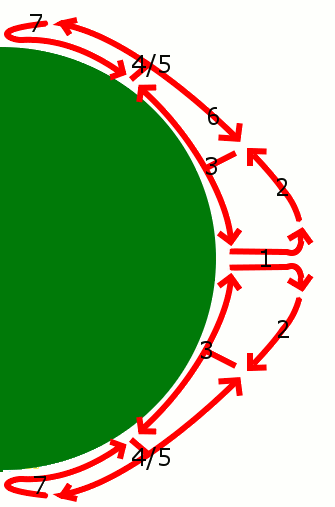
Number and Size of Cells
Here's a possible, highly simplified map of the cells in Jupiter's atmosphere:
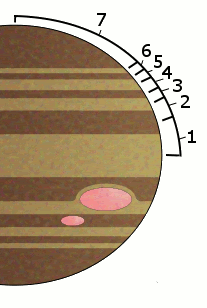
There are seven*, starting at the equator with a pale (rising/low pressure) area, and finishing at the poles with a dark (descending/high pressure) area.
*In all likelihood the polar region is further divided, giving nine, eleven, or even more cells.
Note that the colour bands themselves aren't cells: their middles mark cell boundaries. Sometimes one of the thinner bands will disappear entirely for a while...
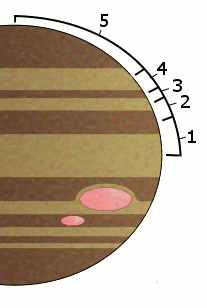
...but there is still an odd number of cells.
The number of atmospheric cells is related to two things: the speed at which the planet rotates on its axis, and the size of the planet. Which is really one thing: the velocity of any point on the planet's surface.
Jupiter is a large, rapidly rotating planet: it rotates on its axis once every ten hours, and has an equatorial circumference of about 449,000km. A bit of maths:
449,000 / 10 = 44,900km/h = 12.47km/s
gives the equatorial velocity - any point at Jupiter's equator is moving at about 12km/s*. The atmosphere is not "attached" to the rotating surface, which causes drag, friction, turbulence, and all sorts of other fun stuff. The same thing happens on Earth, though its equatorial velocity is at a rather more stately pace of 1,674 km/h.
*The actual value, according to Wikipedia, is 12.6 km/s; I'm off because I've rounded the values quite considerably.
The greater the equatorial velocity, the greater the coriolis effect, and the more air flow is deflected longitudinally. The more air flow is deflected longitudinally, the less latitude it covers before cooling and descending. So:
more equatorial velocity = stronger coriolis effect = less latitudinal movement = more, smaller atmospheric cells
The precise cutoff points between cells would be a matter of "how far north can this warm current travel before it cools sufficiently/meets a cold current coming the other way?" - a complicated affair of wind velocities, temperature factors, planet size, and Pazuzu knows what else.
Summary:
for an Earthlike planet:
Stick to three, equally sized cells.
for a non-Earthlike planet:
* Decide how many atmospheric cells your planet has. This will be mostly be based on the equatorial velocity of the planet - higher = more cells, lower = fewer cells. There will be an odd number of cells.
* Decide on their general proportions. I can't offer any help here - equal division seems as good as any, though not strictly necessary.
* If you are doing anything particularly different to Earth's equal three-cell system, draw a diagram, like the one I did of Sal's stage-by-stage explanation of how it works on Earth, of how the air flows within and between cells.
Note: Here I get out of my depth and probably talk a lot of rubbish. Here goes my credibility...
Note: This all highly hypothetical -as far as I'm aware there is no universal theory of atmospheric circulation. Climatologists have a sample size of one for research into Earthlike weather systems, and not a great deal more for the atmospheric workings of other planets. What's worse is that every planet studied has its own quirks - Jupiter has appearing and disappearing cloud bands and a supergiant anticyclonic storm in one hemisphere, Saturn has a hot spot at one of its poles, Venus has doubled polar vortices... With a bit of well thought out bullshitting you could probably get away with just about anything.
Note: Throughout, for equator read thermal equator (around the sun's zenith point, or the latitude at which the sun is directly overheard). You don't need to calculate where these are just yet, just be aware that they do not always match the rotational equivalents. The difference between the two will become important in the next section. Those of you with planets with large (over 30 degree) axial tilts will thank me later.
How They Form
A standard illustration summarising this for the Earth is here: http://en.wikipedia.org/wiki/File:AtmosphCirc2.pngSal wrote:1. Hot air rises on the equator, and spreads out from there
2. The hot air eventually cools, and so falls - in a different place from where it rose
3. The falling air hits the ground and spreads out, in both directions. So some of it goes back toward the tropics, some of it also goes toward the poles.
4. The air heading toward the poles is warmer than the air it meets, so eventually it rises again
5. The risen air spreads out, again in both directions - some toward the pole, some toward the tropics
6. The air going toward the tropics goes as far as meeting the falling are from stage 2, and falls with it
7. The air going toward the poles cools further and falls again. And so on.
8. This creates 'cells' in the atmosphere of circulating air. Earth has three per hemisphere, but if coriolis forces are greater there may be more (because greater deflection means the air doesn't get as far before it cools/warms)
Here is how the cells are formed, following stages 1-7. You can see the circulating cell motion, and also trace the circulation of air from equator to pole and back again.

Number and Size of Cells
There will be an odd number because the cells will always begin with rising air at the equator, and end with sinking air at the poles. An even number of cells would result in a pattern where air rises or falls at both ends of the cycle, which is not at all likely.Sal wrote:9a. However many cells, there will be an odd number.
Here's a possible, highly simplified map of the cells in Jupiter's atmosphere:

There are seven*, starting at the equator with a pale (rising/low pressure) area, and finishing at the poles with a dark (descending/high pressure) area.
*In all likelihood the polar region is further divided, giving nine, eleven, or even more cells.
Note that the colour bands themselves aren't cells: their middles mark cell boundaries. Sometimes one of the thinner bands will disappear entirely for a while...

...but there is still an odd number of cells.
The number of atmospheric cells is related to two things: the speed at which the planet rotates on its axis, and the size of the planet. Which is really one thing: the velocity of any point on the planet's surface.
Jupiter is a large, rapidly rotating planet: it rotates on its axis once every ten hours, and has an equatorial circumference of about 449,000km. A bit of maths:
449,000 / 10 = 44,900km/h = 12.47km/s
gives the equatorial velocity - any point at Jupiter's equator is moving at about 12km/s*. The atmosphere is not "attached" to the rotating surface, which causes drag, friction, turbulence, and all sorts of other fun stuff. The same thing happens on Earth, though its equatorial velocity is at a rather more stately pace of 1,674 km/h.
*The actual value, according to Wikipedia, is 12.6 km/s; I'm off because I've rounded the values quite considerably.
The greater the equatorial velocity, the greater the coriolis effect, and the more air flow is deflected longitudinally. The more air flow is deflected longitudinally, the less latitude it covers before cooling and descending. So:
more equatorial velocity = stronger coriolis effect = less latitudinal movement = more, smaller atmospheric cells
The precise cutoff points between cells would be a matter of "how far north can this warm current travel before it cools sufficiently/meets a cold current coming the other way?" - a complicated affair of wind velocities, temperature factors, planet size, and Pazuzu knows what else.
Summary:
for an Earthlike planet:
Stick to three, equally sized cells.
for a non-Earthlike planet:
* Decide how many atmospheric cells your planet has. This will be mostly be based on the equatorial velocity of the planet - higher = more cells, lower = fewer cells. There will be an odd number of cells.
* Decide on their general proportions. I can't offer any help here - equal division seems as good as any, though not strictly necessary.
* If you are doing anything particularly different to Earth's equal three-cell system, draw a diagram, like the one I did of Sal's stage-by-stage explanation of how it works on Earth, of how the air flows within and between cells.
Last edited by Anguipes on Sun Jun 06, 2010 2:41 am, edited 1 time in total.
"It is quite certain, in particular, that I have always been insane." ~ Aleister Crowley
"Save us all from arrogant men/And all the causes they're for/I won't be righteous again/I'm not that sure any more." ~ Shades of Grey, Billy Joel
"Save us all from arrogant men/And all the causes they're for/I won't be righteous again/I'm not that sure any more." ~ Shades of Grey, Billy Joel
-
Mashmakhan
- Lebom

- Posts: 136
- Joined: Tue Apr 11, 2006 9:46 pm
- Location: Not here anymore. Goodbye, ZBB.
WhoopsAnguipes wrote:Hey, guys, the Church of Exobiology is across the street.
Thanks for that link, patiku. I have joined and posted my introduction.patiku wrote:Here's the address.Anguipes wrote:Hey, guys, the Church of Exobiology is across the street.
_________________
Now, back on topic: What happens when a planet is smaller and has a lighter density? Will that effect the equatorial velosity and rotation speed? Will the planet have less atmospheric cells, more atmospheric cells, or will the cells just be smaller?
The connection between planetary density and rotation speed (if there is one, I'm not sure) is a bit beyond what I'm discussing here. Not that I'm not interested in the answer, but I don't want to get too sidetracked.Mashmakhan wrote:Now, back on topic: What happens when a planet is smaller and has a lighter density? Will that effect the equatorial velosity and rotation speed? Will the planet have less atmospheric cells, more atmospheric cells, or will the cells just be smaller?
Cells sizes are proportional - you could fit the Earth in one of Jupiter's "small" cells. A small planet would have a smaller absolute size of cell, but not necessarily more cells because of it.
Below a certain velocity threshold (don't ask me what it is), you end up with what is essentially a one-cell system - hot air at the equator doesn't fall until it hits the pole, and cold polar winds are the planet's only surface winds, pushing down from pole to equator where they heat up and continue the cycle. A very large planet might avoid this because of the distances involved, I'm not sure.
Final note: don't confuse equatorial rotation velocity with (equatorial) escape velocity. I'm talking about the former.
"It is quite certain, in particular, that I have always been insane." ~ Aleister Crowley
"Save us all from arrogant men/And all the causes they're for/I won't be righteous again/I'm not that sure any more." ~ Shades of Grey, Billy Joel
"Save us all from arrogant men/And all the causes they're for/I won't be righteous again/I'm not that sure any more." ~ Shades of Grey, Billy Joel
-
Mashmakhan
- Lebom

- Posts: 136
- Joined: Tue Apr 11, 2006 9:46 pm
- Location: Not here anymore. Goodbye, ZBB.
I think this answers my question. Thank you.Anguipes wrote:Cells sizes are proportional - you could fit the Earth in one of Jupiter's "small" cells. A small planet would have a smaller absolute size of cell, but not necessarily more cells because of it.
I assumed as much. The former having to do with rotation speed and the latter having to do with gravity. I think Geoff/bricka discusses this on his old website so I can always go back to that. And yes, I know where to find itFinal note: don't confuse equatorial rotation velocity with (equatorial) escape velocity. I'm talking about the former.
Interlude: Introducing Blobworld (GIMPin')
Menducia is bloody stupid to use as an example, so I'm putting it on hold for a while.
Instead:
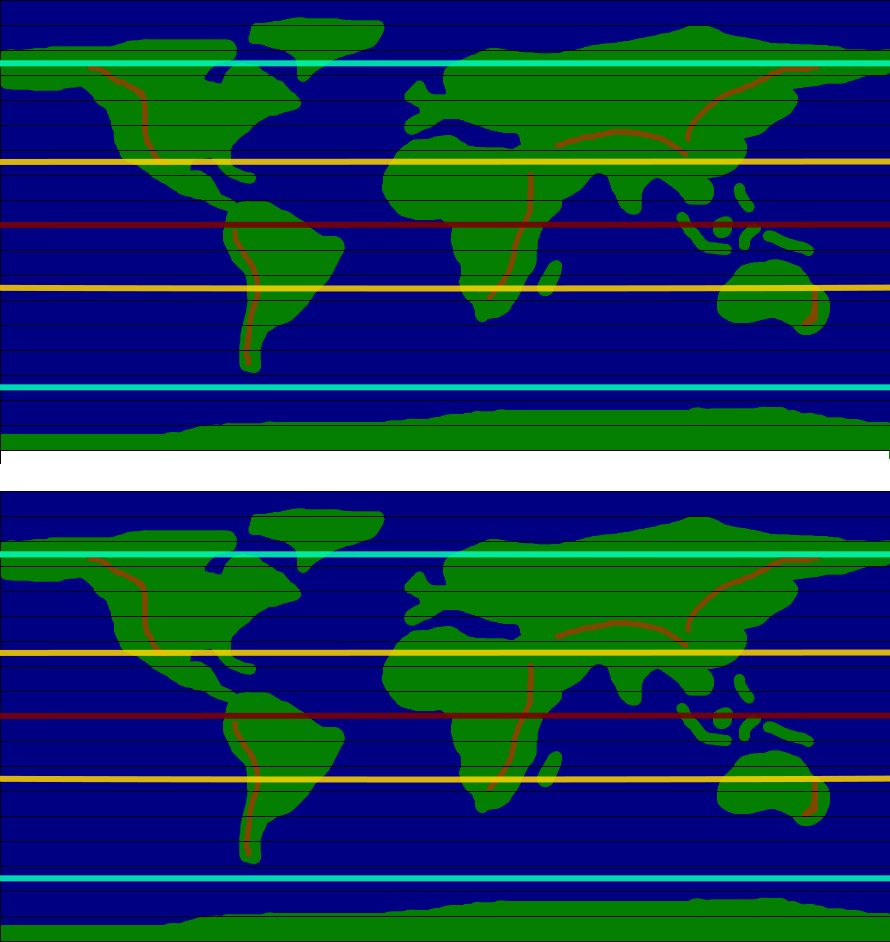
This is Blobworld. It's an Earthlike planet (*cough*) with an axial tilt of about 25 degrees. Before the next stage of the tutorial, you'll want something a bit like this for your own world.
There are two layers on this image at the moment: the main background map and the lines of latitude. The background map shows land, sea, and mountain ranges. The latitude layer marks lines of latitude in increments of 10 degrees, plus the equator, tropics and polar circles.
There are two copies of the map. That's because I'll need summer and winter maps, and I prefer to see them both at once. You can have them in separate image files if you prefer. For the moment though, they should be identical.
GIMP Summary:
Map Layer:
Bucket Fill tool (seas)
Paint tool (continents and mountain ranges)
Latitude Lines layer:
Filters\Render\Pattern\Grid (latitude lines)
Paths tool (equator/tropics/polar circles lines)
Menducia is bloody stupid to use as an example, so I'm putting it on hold for a while.
Instead:

This is Blobworld. It's an Earthlike planet (*cough*) with an axial tilt of about 25 degrees. Before the next stage of the tutorial, you'll want something a bit like this for your own world.
There are two layers on this image at the moment: the main background map and the lines of latitude. The background map shows land, sea, and mountain ranges. The latitude layer marks lines of latitude in increments of 10 degrees, plus the equator, tropics and polar circles.
There are two copies of the map. That's because I'll need summer and winter maps, and I prefer to see them both at once. You can have them in separate image files if you prefer. For the moment though, they should be identical.
GIMP Summary:
Map Layer:
Bucket Fill tool (seas)
Paint tool (continents and mountain ranges)
Latitude Lines layer:
Filters\Render\Pattern\Grid (latitude lines)
Paths tool (equator/tropics/polar circles lines)
"It is quite certain, in particular, that I have always been insane." ~ Aleister Crowley
"Save us all from arrogant men/And all the causes they're for/I won't be righteous again/I'm not that sure any more." ~ Shades of Grey, Billy Joel
"Save us all from arrogant men/And all the causes they're for/I won't be righteous again/I'm not that sure any more." ~ Shades of Grey, Billy Joel
Atmospheric Cells II
Cell Boundaries and Pressure
At the boundaries between cells bands of high or low pressure form. Low pressure bands form where air is rising; on Earth, or any comparable three-cell system, at the equator (the ITCZ Inter-Tropical Convergence Zone) and at the Polar Front (boundary between the polar and Ferrel cells). Storms and generally unpredictable weather are associated with these low-pressure bands. High pressure bands form at boundaries where air is falling (e.g. the Ferrel/Hadley cell border). These areas are associated with stable weather and very low precipitation - moisture in these areas tends to manifest as fog. More on this later - for now, we'll just work out where the damn things are.
Seasonal Migration of Cell Boundaries
When the circulation of air is driven by solar heating, the most important seasonal migration is that of the hot equatorial zone that forms the border between the two air circulation hemispheres - the thermal equator, which in turn forms the ICTZ low pressure belt. Over land (or high specific heat capacity areas) this band tends to follow the sun's zenith, or the latitude at which the sun may be directly overhead. This may sound like it's leading to some complicated trigonometry, but it isn't - broadly, the sun will be overhead at 0 degrees latitude during the equinoxes, at a latitude equal to the planet's axial inclination at the solstices, and move smoothly from one stage to the next (equinox [0 lat] -> summer solstice [max lat] -> equinox [0 lat] -> winter solstice [min lat], and so on). Over oceans (or low specific heat capacity areas) the movement will be much less pronounced, due to the less variable temperature.
On Blobworld, the ITCZ would lie about along the black line during north hemisphere summer (top) and winter (bottom):
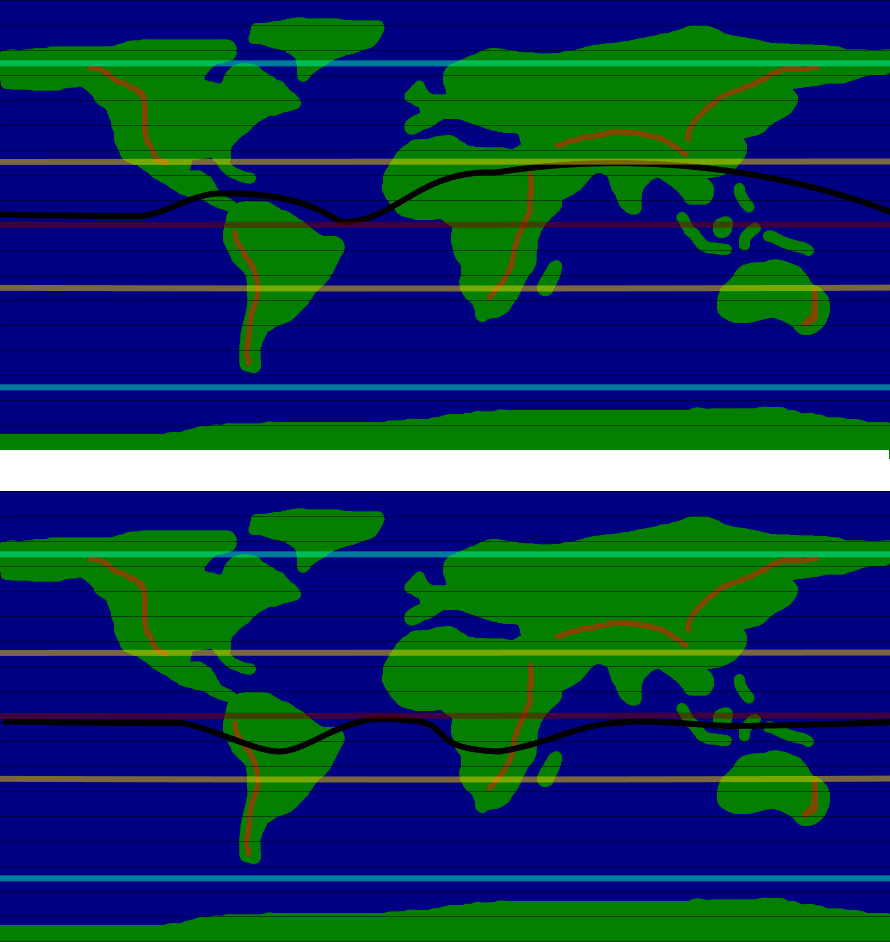
In the northern hemisphere summer (top map) the ICTZ moves north - slightly over the oceans, more so over land, and at its greatest, approaching the boundary of the tropics, where there is the largest landmass nearby. In the northern hemisphere winter (bottom map) it moves south - the effect is less pronounced because the landmasses in the southern hemisphere are smaller and the ocean area is greater.
As long as the areas of least heating remain about at the poles, the boundaries of other cells are pushed up or pulled down proportionally in latitude. Proportionally is the key word here - regardless of anything else, a cell will occupy the same proportion of latitude (say, a third), between the ICTZ and the pole. The moving ICTZ causes the specific latitudes and absolute sizes of the cells to expand and contract, but not these proportions. The presence or absence of land also does not significantly affect these boundaries [confirmation needed]. On Blobworld:
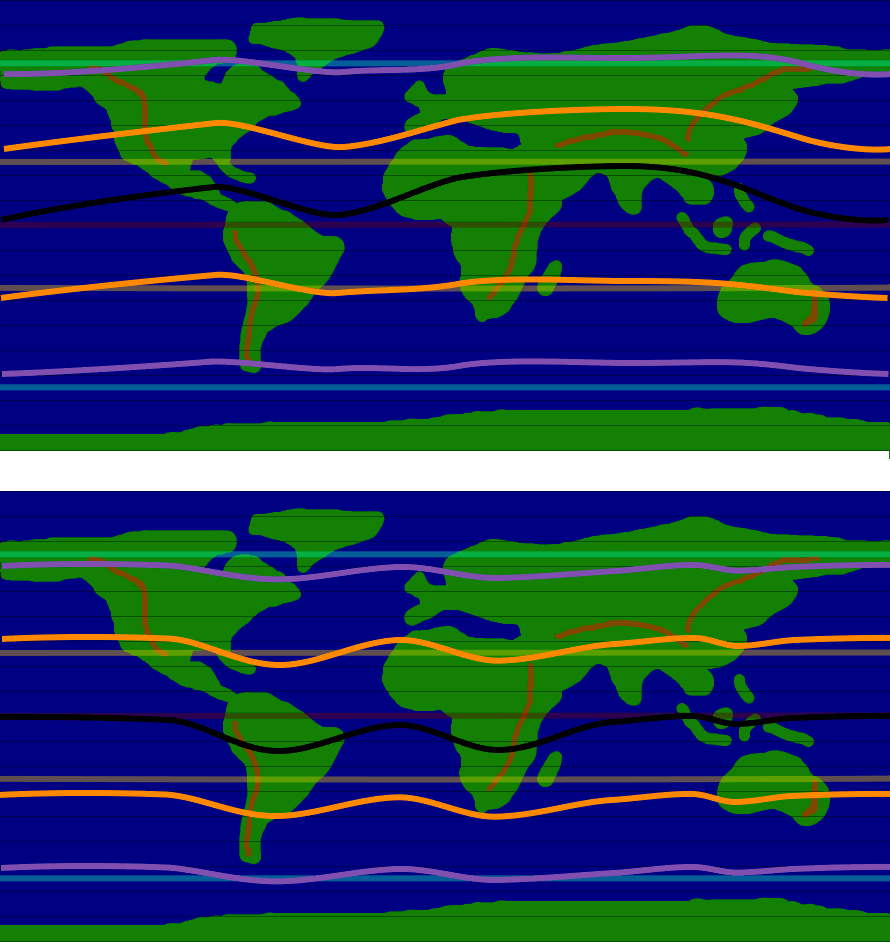
In the northern hemisphere summer (top), the Ferrel/Hadley cell borders (orange), and thier associated wind and rain patterns, are pushed up in latitude, as are the Polar/Ferrel boundaries (purple). Broadly, in the northern hemisphere this means that only a small area is affected by polar winds and the warm/stable Ferrel/Hadley border weather pattern reaches higher latitudes, as does the rains of the ICTZ - all part of what forms "summer" conditions. In the southern hemisphere the situation is reversed - a larger area under the polar cell, the Ferrel/Hadley high pressure systems moving further towards the equator, and the stormy ICTZ moving away from outer tropical areas and taking the rains with it - all part of the "winter" pattern. In the second map, the basics are reversed, with a "summer" southern hemisphere and a "winter" northern one.
If you have a reasonably Earthlike world, especially if it has an Earthlike axial tilt, you probably have all the information you need to add these cell boundaries/pressure bands to your maps. If you have a more exotic axial tilt, you might want to stay tuned for the next section, in which I explore their effects.
GIMP Summary:
New layer - Cell boundaries
Paths tool
Cell Boundaries and Pressure
At the boundaries between cells bands of high or low pressure form. Low pressure bands form where air is rising; on Earth, or any comparable three-cell system, at the equator (the ITCZ Inter-Tropical Convergence Zone) and at the Polar Front (boundary between the polar and Ferrel cells). Storms and generally unpredictable weather are associated with these low-pressure bands. High pressure bands form at boundaries where air is falling (e.g. the Ferrel/Hadley cell border). These areas are associated with stable weather and very low precipitation - moisture in these areas tends to manifest as fog. More on this later - for now, we'll just work out where the damn things are.
Seasonal Migration of Cell Boundaries
When the circulation of air is driven by solar heating, the most important seasonal migration is that of the hot equatorial zone that forms the border between the two air circulation hemispheres - the thermal equator, which in turn forms the ICTZ low pressure belt. Over land (or high specific heat capacity areas) this band tends to follow the sun's zenith, or the latitude at which the sun may be directly overhead. This may sound like it's leading to some complicated trigonometry, but it isn't - broadly, the sun will be overhead at 0 degrees latitude during the equinoxes, at a latitude equal to the planet's axial inclination at the solstices, and move smoothly from one stage to the next (equinox [0 lat] -> summer solstice [max lat] -> equinox [0 lat] -> winter solstice [min lat], and so on). Over oceans (or low specific heat capacity areas) the movement will be much less pronounced, due to the less variable temperature.
On Blobworld, the ITCZ would lie about along the black line during north hemisphere summer (top) and winter (bottom):

In the northern hemisphere summer (top map) the ICTZ moves north - slightly over the oceans, more so over land, and at its greatest, approaching the boundary of the tropics, where there is the largest landmass nearby. In the northern hemisphere winter (bottom map) it moves south - the effect is less pronounced because the landmasses in the southern hemisphere are smaller and the ocean area is greater.
As long as the areas of least heating remain about at the poles, the boundaries of other cells are pushed up or pulled down proportionally in latitude. Proportionally is the key word here - regardless of anything else, a cell will occupy the same proportion of latitude (say, a third), between the ICTZ and the pole. The moving ICTZ causes the specific latitudes and absolute sizes of the cells to expand and contract, but not these proportions. The presence or absence of land also does not significantly affect these boundaries [confirmation needed]. On Blobworld:

In the northern hemisphere summer (top), the Ferrel/Hadley cell borders (orange), and thier associated wind and rain patterns, are pushed up in latitude, as are the Polar/Ferrel boundaries (purple). Broadly, in the northern hemisphere this means that only a small area is affected by polar winds and the warm/stable Ferrel/Hadley border weather pattern reaches higher latitudes, as does the rains of the ICTZ - all part of what forms "summer" conditions. In the southern hemisphere the situation is reversed - a larger area under the polar cell, the Ferrel/Hadley high pressure systems moving further towards the equator, and the stormy ICTZ moving away from outer tropical areas and taking the rains with it - all part of the "winter" pattern. In the second map, the basics are reversed, with a "summer" southern hemisphere and a "winter" northern one.
If you have a reasonably Earthlike world, especially if it has an Earthlike axial tilt, you probably have all the information you need to add these cell boundaries/pressure bands to your maps. If you have a more exotic axial tilt, you might want to stay tuned for the next section, in which I explore their effects.
GIMP Summary:
New layer - Cell boundaries
Paths tool
"It is quite certain, in particular, that I have always been insane." ~ Aleister Crowley
"Save us all from arrogant men/And all the causes they're for/I won't be righteous again/I'm not that sure any more." ~ Shades of Grey, Billy Joel
"Save us all from arrogant men/And all the causes they're for/I won't be righteous again/I'm not that sure any more." ~ Shades of Grey, Billy Joel
Propoably total bollocks, but I tried.
What if Blobworld had a more extreme axial tilt, say 45 degrees? Then something a little like this would happen:
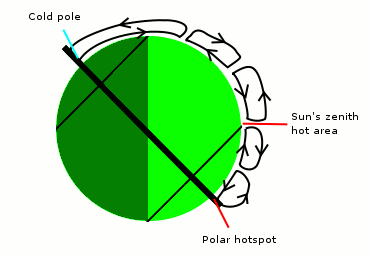
At midwinter, the cold winter pole, pointed away from the sun, will have been in constant darkness for many months. Things will get steadily warmer as you go south until you hit the sun's zenith point (or rather, just below it, somewhere in the perma-daylight area). From there things get a bit more complicated, as a balance between decreasing sun angle (cooling) and increasing time in sunlight (heating) starts to come into play. The summer pole, in constant sunlight for months, will become very hot, forming a polar hotspot.
The larger the planet's axial inclination, the closer the summer polar hotspot and the hot area formed by the sun's zenith point will be, until eventually the two merge (on worlds with an axial inclination of over about 50 degrees(?)).
Here's a (very) rough idea of what the map of cell boundaries on a 40-45 degree blobworld might look like:
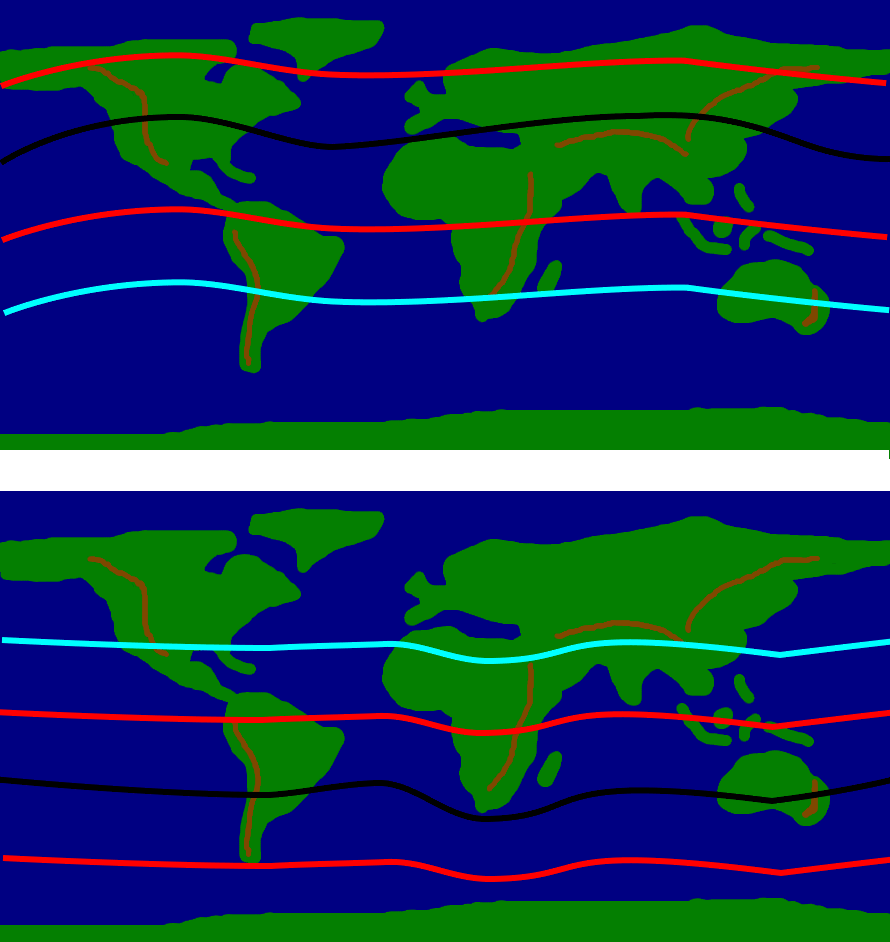
Black marks the heat equator (rising air), red marks boundaries with falling air, and light blue mark boundaries with rising air.
Between these summer and winter extremes is something looking more like the ideal three-cell system. From there (equinoxes), the cell boundaries migrate up and down towards the pole closest to the sun - as summer comes in, the polar cell of the hot pole shrinks and disappears. Moving into autumn the pole cools again, the polar cell reforms, and becomes increasingly dominant as the hemisphere cools.
What if Blobworld had a more extreme axial tilt, say 45 degrees? Then something a little like this would happen:

At midwinter, the cold winter pole, pointed away from the sun, will have been in constant darkness for many months. Things will get steadily warmer as you go south until you hit the sun's zenith point (or rather, just below it, somewhere in the perma-daylight area). From there things get a bit more complicated, as a balance between decreasing sun angle (cooling) and increasing time in sunlight (heating) starts to come into play. The summer pole, in constant sunlight for months, will become very hot, forming a polar hotspot.
The larger the planet's axial inclination, the closer the summer polar hotspot and the hot area formed by the sun's zenith point will be, until eventually the two merge (on worlds with an axial inclination of over about 50 degrees(?)).
Here's a (very) rough idea of what the map of cell boundaries on a 40-45 degree blobworld might look like:

Black marks the heat equator (rising air), red marks boundaries with falling air, and light blue mark boundaries with rising air.
Between these summer and winter extremes is something looking more like the ideal three-cell system. From there (equinoxes), the cell boundaries migrate up and down towards the pole closest to the sun - as summer comes in, the polar cell of the hot pole shrinks and disappears. Moving into autumn the pole cools again, the polar cell reforms, and becomes increasingly dominant as the hemisphere cools.
"It is quite certain, in particular, that I have always been insane." ~ Aleister Crowley
"Save us all from arrogant men/And all the causes they're for/I won't be righteous again/I'm not that sure any more." ~ Shades of Grey, Billy Joel
"Save us all from arrogant men/And all the causes they're for/I won't be righteous again/I'm not that sure any more." ~ Shades of Grey, Billy Joel
Pressure
The combination of continents and cell boundaries forms the framework for working out the prevailing winds at different times of year. First, you'll need a map of the areas of high and low pressure.
High pressure systems can be found:
At cell boundaries with falling air
Over land in winter (caused by land cooling)
And low pressure ones:
At cell boundaries with rising air
Over land in summer (caused by land heating)
Land pressure tends to override the expectation at cell boundaries - part of the reason why they tend to bend around land areas. Continental areas break up high/low pressure bands entirely with their interior pressure systems.
GIMP - Making a Pressure Map
Make a new layer, called "pressure", and move it to the top if necessary. Fill it with 50% grey (#7f7f7f), then turn the transparency to about 50%. Make sure you can see your continent map and cell boundaries through it.
Using the brush tool, blob on areas of white (high pressure) over the winter hemisphere continents, and black (low pressure) over the summer hemisphere ones. Land at either pole will be cold and therefore slightly high pressure, unless your planet experiences hot/cold poles as described above.
Over the oceans, put low pressure areas (black) around the cell boundaries where air is rising, and high pressure ones (white) where air is falling.
Using a smaller brush, go over the pressure bands to join up areas of the same colour.
You should end up with something like this:
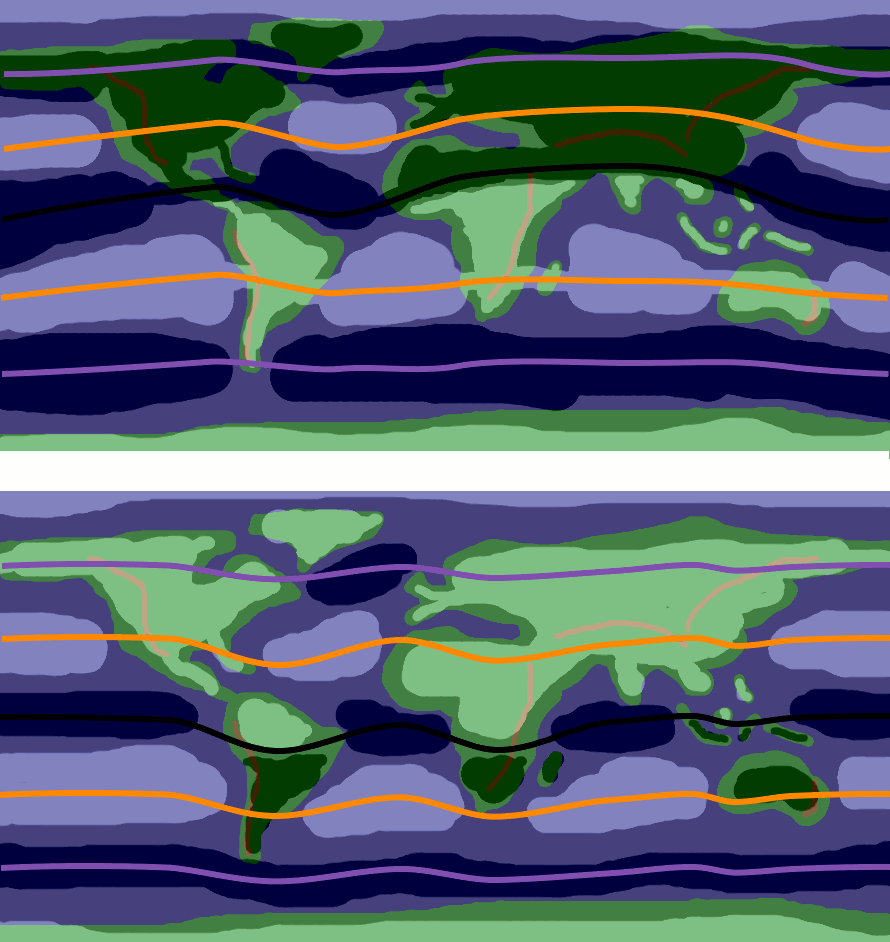
Not very impressive. Next, apply a blur - exactly how much will depend on the size of your image and how much detail you want to keep from your original, but it should leave a smooth gradient between the dark and light areas. I used a 150 gaussian blur. Apply colors\auto\normalise to the layer.
There are several directions you can go from here.
TIP: Make a copy of your pressure layer before going on. That way you can experiment with different looks without losing your original.
Adding a Colour Gradient
Select your max pressure colour (I'm using red) as the background colour, and your min pressure colour (light blue) as the foreground colour. Apply colors\map\gradient map. Simple as that!
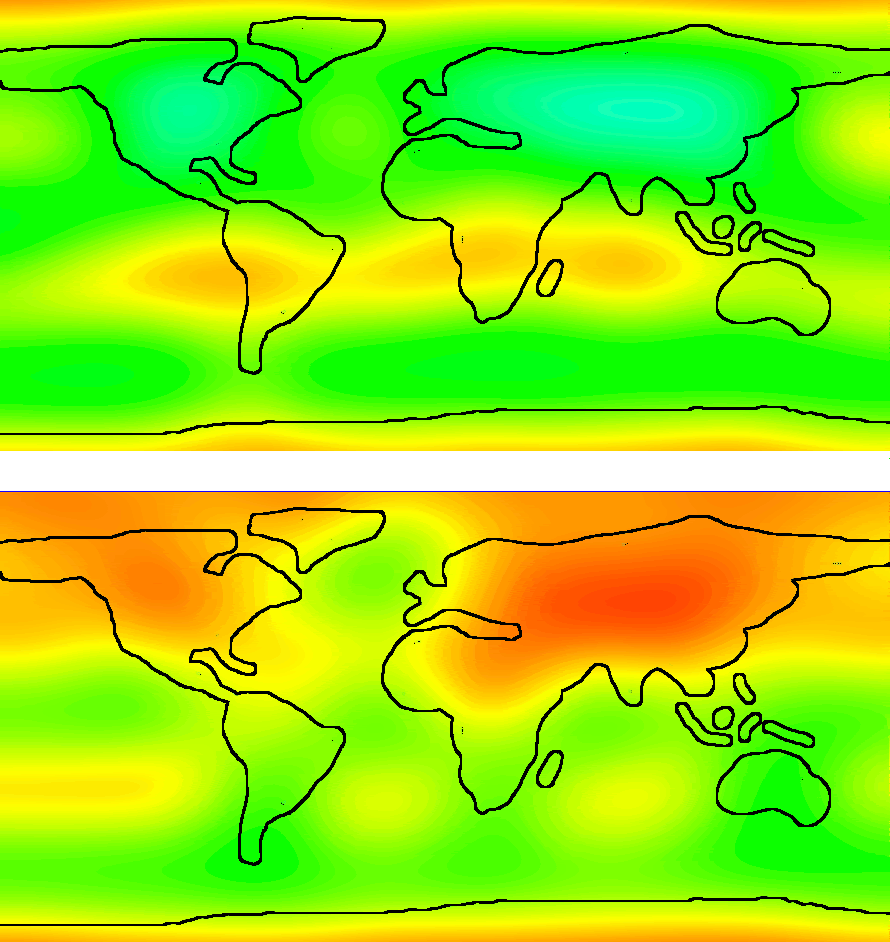
Layer1 - pressure map with colour
Layer2 - continent outline
Posterizing
Posterize reduces the number of colours used - it will turn the smooth gradient you got from the blur into solid blocks of colour. Experiment with different levels of posterization - fewer levels will give an easy to read, but less detailed map, while more levels will give a more detailed look.
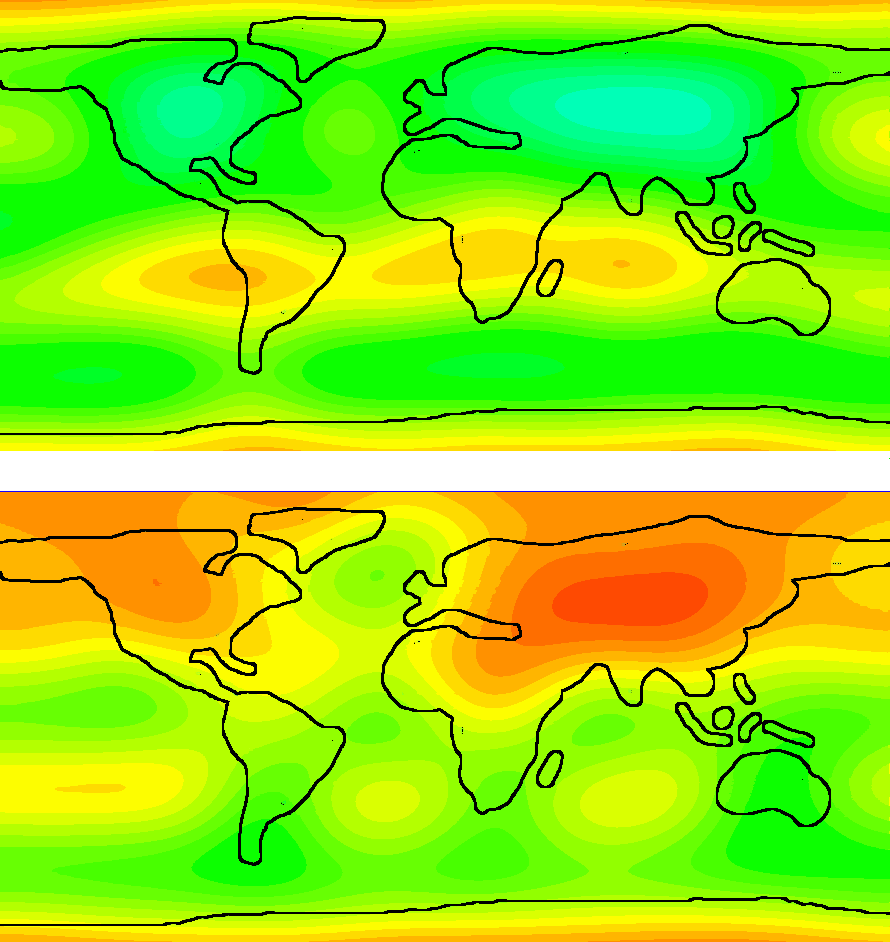
Layer1 - pressure map with colour, posterised
Layer2 - continent outline
Isobars
An isobar map can be made by posterizing then applying filters\edge detect\edge.
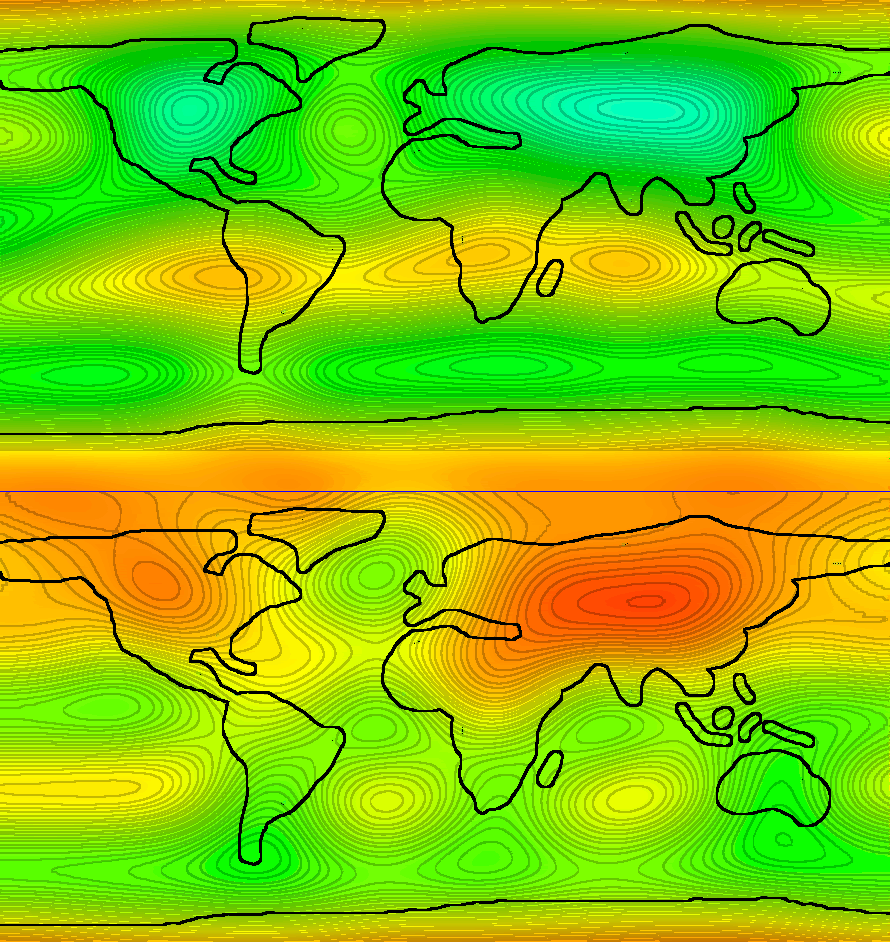
Layer1 - pressure map with colour
Layer2 - isobar map (recoloured to black and transparent)
Layer2 - continent outline
The combination of continents and cell boundaries forms the framework for working out the prevailing winds at different times of year. First, you'll need a map of the areas of high and low pressure.
High pressure systems can be found:
At cell boundaries with falling air
Over land in winter (caused by land cooling)
And low pressure ones:
At cell boundaries with rising air
Over land in summer (caused by land heating)
Land pressure tends to override the expectation at cell boundaries - part of the reason why they tend to bend around land areas. Continental areas break up high/low pressure bands entirely with their interior pressure systems.
GIMP - Making a Pressure Map
Make a new layer, called "pressure", and move it to the top if necessary. Fill it with 50% grey (#7f7f7f), then turn the transparency to about 50%. Make sure you can see your continent map and cell boundaries through it.
Using the brush tool, blob on areas of white (high pressure) over the winter hemisphere continents, and black (low pressure) over the summer hemisphere ones. Land at either pole will be cold and therefore slightly high pressure, unless your planet experiences hot/cold poles as described above.
Over the oceans, put low pressure areas (black) around the cell boundaries where air is rising, and high pressure ones (white) where air is falling.
Using a smaller brush, go over the pressure bands to join up areas of the same colour.
You should end up with something like this:

Not very impressive. Next, apply a blur - exactly how much will depend on the size of your image and how much detail you want to keep from your original, but it should leave a smooth gradient between the dark and light areas. I used a 150 gaussian blur. Apply colors\auto\normalise to the layer.
There are several directions you can go from here.
TIP: Make a copy of your pressure layer before going on. That way you can experiment with different looks without losing your original.
Adding a Colour Gradient
Select your max pressure colour (I'm using red) as the background colour, and your min pressure colour (light blue) as the foreground colour. Apply colors\map\gradient map. Simple as that!

Layer1 - pressure map with colour
Layer2 - continent outline
Posterizing
Posterize reduces the number of colours used - it will turn the smooth gradient you got from the blur into solid blocks of colour. Experiment with different levels of posterization - fewer levels will give an easy to read, but less detailed map, while more levels will give a more detailed look.

Layer1 - pressure map with colour, posterised
Layer2 - continent outline
Isobars
An isobar map can be made by posterizing then applying filters\edge detect\edge.

Layer1 - pressure map with colour
Layer2 - isobar map (recoloured to black and transparent)
Layer2 - continent outline
"It is quite certain, in particular, that I have always been insane." ~ Aleister Crowley
"Save us all from arrogant men/And all the causes they're for/I won't be righteous again/I'm not that sure any more." ~ Shades of Grey, Billy Joel
"Save us all from arrogant men/And all the causes they're for/I won't be righteous again/I'm not that sure any more." ~ Shades of Grey, Billy Joel
Prevailing Winds
Winds flow from high pressure areas to low pressure ones, with some deflection from the coriolis effect. The coriolis effect will cause winds to spiral out of high pressure zones (clockwise in the northern hemisphere, anticlockwise in the southern) and into low pressure zones (anticlockwise in the northern hemisphere, clockwise in the southern).
GIMP - Working out the prevailing winds from your pressure map
This method will give you a rough picture of the direction of the prevailing winds.
On a new layer ("grid"), add a grid to your map. In GIMP, you can do this easily with filters\render\pattern\grid. The smaller the squares the more detail you'll pick up, but there'll be more work to do.
Working on a new layer ("winds"), pick a square, and work out the rough direction (N, NW, W, SW, S, SE, E, S) of the pressure gradient, from high to low. Then, to simulate deflection from coriolis, rotate it one place clockwise in the northern hemisphere (above the rotational equator), or one place anticlockwise in the southern hemisphere, and put an arrow pointing in that direction in the square. So, if the pressure gradient goes north, the wind direction will be NE (in the northern hemisphere) or NW (in the southern hemisphere).
Repeat the process for every square until you've got the winds for your whole map. The large scale spiralling from high pressure zones to low pressure ones will build up naturally.
To keep the time I spend making example maps down, I've used a larger grid than I would recommend. The equator also runs right through the middle of one row of squares - try to avoid this.
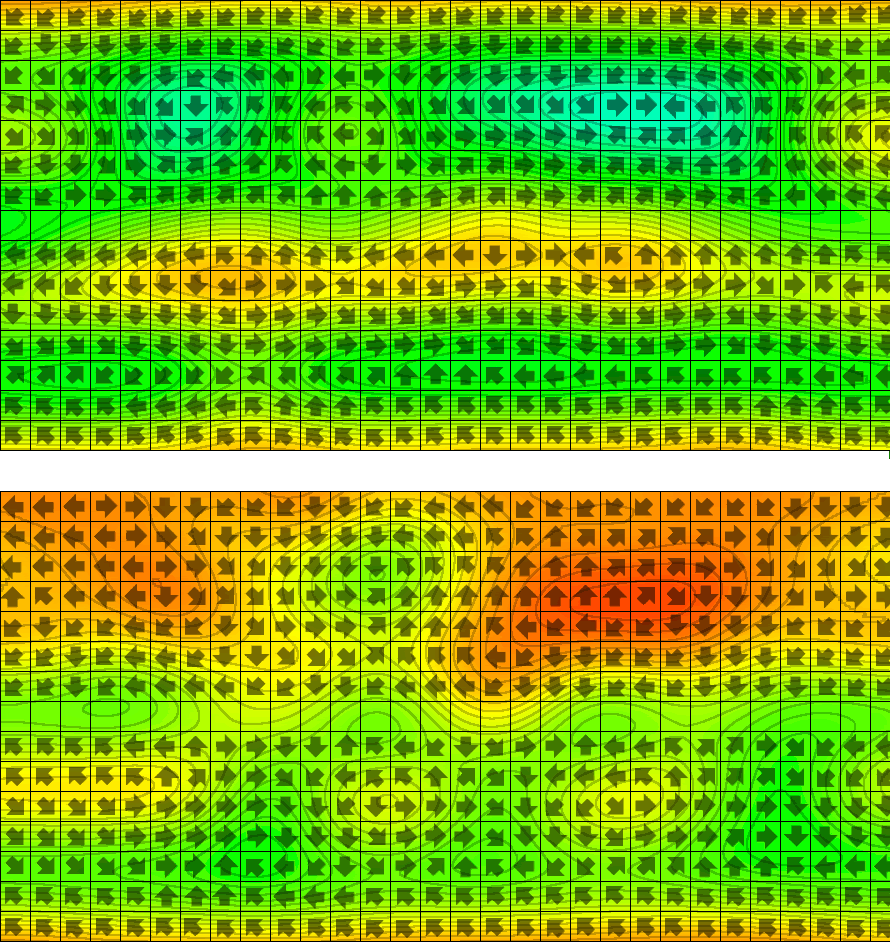
Pressure, grid and wind directions
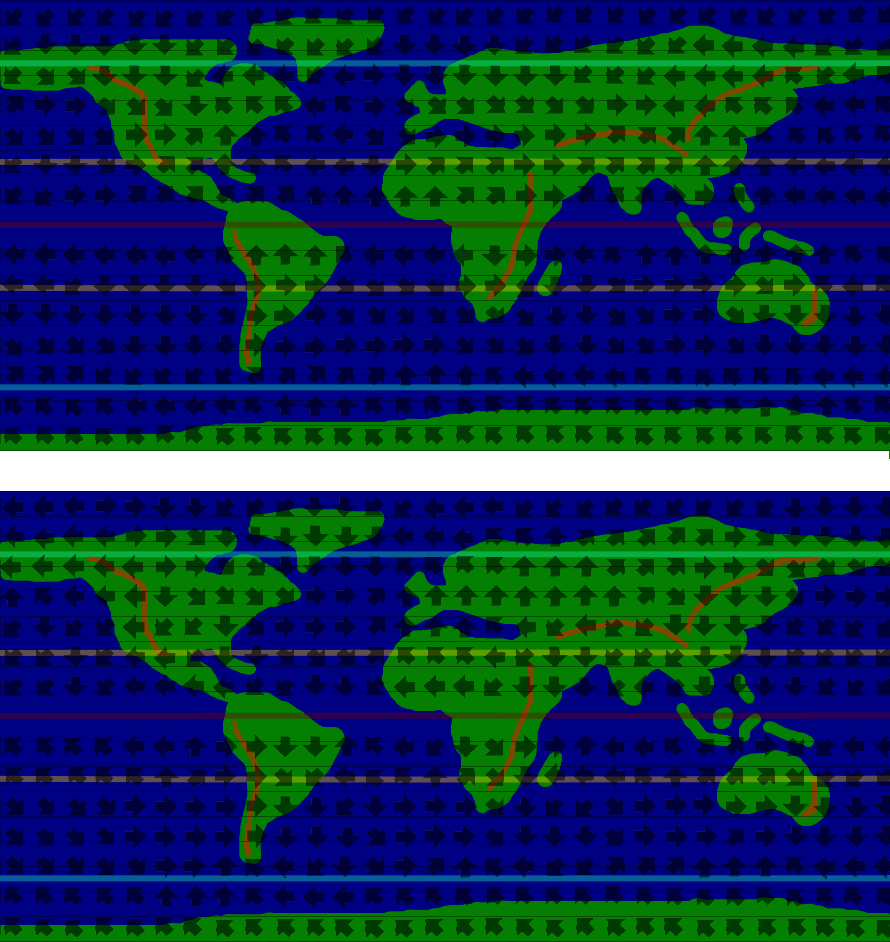
Wind directions, latitudes and continents
Wind Speeds
Wind speeds are generally driven by more local, small-scale factors than we're dealing with here, but generally the greater the pressure variation in an area, the faster the winds will be. I would not trust the method I gave above to produce anything like an accurate enough picture of relative pressure for trustworthy wind speeds (though if you really want to you can get around it with the old conworlder's gambit "this abstraction is in fact an accurate representation, because unknown anomalies/magic/I said so"). However, you can assume that the fastest winds will be where a high pressure system and a low pressure one are close together, and that areas with very uniform pressure will be generally calm.
Winds flow from high pressure areas to low pressure ones, with some deflection from the coriolis effect. The coriolis effect will cause winds to spiral out of high pressure zones (clockwise in the northern hemisphere, anticlockwise in the southern) and into low pressure zones (anticlockwise in the northern hemisphere, clockwise in the southern).
GIMP - Working out the prevailing winds from your pressure map
This method will give you a rough picture of the direction of the prevailing winds.
On a new layer ("grid"), add a grid to your map. In GIMP, you can do this easily with filters\render\pattern\grid. The smaller the squares the more detail you'll pick up, but there'll be more work to do.
Working on a new layer ("winds"), pick a square, and work out the rough direction (N, NW, W, SW, S, SE, E, S) of the pressure gradient, from high to low. Then, to simulate deflection from coriolis, rotate it one place clockwise in the northern hemisphere (above the rotational equator), or one place anticlockwise in the southern hemisphere, and put an arrow pointing in that direction in the square. So, if the pressure gradient goes north, the wind direction will be NE (in the northern hemisphere) or NW (in the southern hemisphere).
Repeat the process for every square until you've got the winds for your whole map. The large scale spiralling from high pressure zones to low pressure ones will build up naturally.
To keep the time I spend making example maps down, I've used a larger grid than I would recommend. The equator also runs right through the middle of one row of squares - try to avoid this.

Pressure, grid and wind directions

Wind directions, latitudes and continents
Wind Speeds
Wind speeds are generally driven by more local, small-scale factors than we're dealing with here, but generally the greater the pressure variation in an area, the faster the winds will be. I would not trust the method I gave above to produce anything like an accurate enough picture of relative pressure for trustworthy wind speeds (though if you really want to you can get around it with the old conworlder's gambit "this abstraction is in fact an accurate representation, because unknown anomalies/magic/I said so"). However, you can assume that the fastest winds will be where a high pressure system and a low pressure one are close together, and that areas with very uniform pressure will be generally calm.
"It is quite certain, in particular, that I have always been insane." ~ Aleister Crowley
"Save us all from arrogant men/And all the causes they're for/I won't be righteous again/I'm not that sure any more." ~ Shades of Grey, Billy Joel
"Save us all from arrogant men/And all the causes they're for/I won't be righteous again/I'm not that sure any more." ~ Shades of Grey, Billy Joel
Hope this is still being useful to people.
If anyone knows anything about storm, hurricane and tornado formation, that would be a really useful addition.
If anyone knows anything about storm, hurricane and tornado formation, that would be a really useful addition.
"It is quite certain, in particular, that I have always been insane." ~ Aleister Crowley
"Save us all from arrogant men/And all the causes they're for/I won't be righteous again/I'm not that sure any more." ~ Shades of Grey, Billy Joel
"Save us all from arrogant men/And all the causes they're for/I won't be righteous again/I'm not that sure any more." ~ Shades of Grey, Billy Joel
-
Cadeshadow
- Niš

- Posts: 8
- Joined: Wed Apr 09, 2008 11:28 pm
I am still working on this 
I'm struggling to put together anything worthwhile on ocean currents, especially for planets with very unstable pressure zones.
I'm struggling to put together anything worthwhile on ocean currents, especially for planets with very unstable pressure zones.
"It is quite certain, in particular, that I have always been insane." ~ Aleister Crowley
"Save us all from arrogant men/And all the causes they're for/I won't be righteous again/I'm not that sure any more." ~ Shades of Grey, Billy Joel
"Save us all from arrogant men/And all the causes they're for/I won't be righteous again/I'm not that sure any more." ~ Shades of Grey, Billy Joel
The best conditions for hurricanes to form/intensify:
- Warm sea surface temperatures (this is why hurricanes form in the tropics, and why climatologists predict increases in hurricane frequency and intensity under global warming conditions)
- A wide east-west swath of generally unbroken ocean (again, in the tropics. This also provides a useful tip if you don't want many hurricanes - avoid large oceanic east-west swaths in the tropics.
- You don't want the wind to be too fast aloft, or to have too much shear. Shear kills off hurricanes, and high winds will push them fast enough they won't have a chance to intensify enough before reaching land. (This is why hurricanes typically form in the summer and autumn - the jet stream is far enough poleward that it doesn't interfere.)
- I think it helps if there's a large desert just to the east of the ocean, especially if the ITCZ runs right over it in summer. The heating up of the desert provides nice buoyant air, as well as dust particles that make perfect cloud condensation nuclei.
The Atlantic is a breeding ground for hurricanes because it basically has all of these.
- Warm sea surface temperatures (this is why hurricanes form in the tropics, and why climatologists predict increases in hurricane frequency and intensity under global warming conditions)
- A wide east-west swath of generally unbroken ocean (again, in the tropics. This also provides a useful tip if you don't want many hurricanes - avoid large oceanic east-west swaths in the tropics.
- You don't want the wind to be too fast aloft, or to have too much shear. Shear kills off hurricanes, and high winds will push them fast enough they won't have a chance to intensify enough before reaching land. (This is why hurricanes typically form in the summer and autumn - the jet stream is far enough poleward that it doesn't interfere.)
- I think it helps if there's a large desert just to the east of the ocean, especially if the ITCZ runs right over it in summer. The heating up of the desert provides nice buoyant air, as well as dust particles that make perfect cloud condensation nuclei.
The Atlantic is a breeding ground for hurricanes because it basically has all of these.
- LinguistCat
- Avisaru

- Posts: 250
- Joined: Thu Apr 13, 2006 7:24 pm
- Location: Off on the side
-
Gray Richardson
- Lebom

- Posts: 80
- Joined: Sun Jan 03, 2010 6:11 pm
- Location: Austin, TX
I very much appreciate this thread; you have my rapt attention. I have not wanted to clutter the thread with copious and distracting adulation, but you deserve it and should know it's there, even if unspoken.
But since I am posting I feel I should say something on topic, so I am curious if you could address jet streams. I gather there is an upper atmosphere air jet stream, and then there is an ocean current jet stream (do I have that right?) How does the arrangement of continents affect that--especially if you have really long continents (like North & South America) that present substantial barriers to the flow of currents. And moreover, how would it affect the flow of such currents if you had narrow openings in such barriers, say if, for example, part of Central America were missing.
But since I am posting I feel I should say something on topic, so I am curious if you could address jet streams. I gather there is an upper atmosphere air jet stream, and then there is an ocean current jet stream (do I have that right?) How does the arrangement of continents affect that--especially if you have really long continents (like North & South America) that present substantial barriers to the flow of currents. And moreover, how would it affect the flow of such currents if you had narrow openings in such barriers, say if, for example, part of Central America were missing.
Simply awesome. I'm doing this for my conworld, since I finally decided on coming up with a geography I like, and your guide is just turning out to be awesome. This should be a website 
So I guess I'll be cheating here, because my conworld will end up with quite a simpler climatology than earth; just one cell per hemisphere, mainly because the rotation speed is half that of earth [though there might be three, I have no idea where the cut speed is], and since my axial tilt is 1,3° or something, there's not gonna be any winter or summer either.
Anyways, dude, this is awesome, keep it up pretty please
EDIT: nah, it will have three cells; just one is too boring, besides, it doesn't spin THAT slow... day lasts around 40 hours.
So I guess I'll be cheating here, because my conworld will end up with quite a simpler climatology than earth; just one cell per hemisphere, mainly because the rotation speed is half that of earth [though there might be three, I have no idea where the cut speed is], and since my axial tilt is 1,3° or something, there's not gonna be any winter or summer either.
Anyways, dude, this is awesome, keep it up pretty please
EDIT: nah, it will have three cells; just one is too boring, besides, it doesn't spin THAT slow... day lasts around 40 hours.
-
Mashmakhan
- Lebom

- Posts: 136
- Joined: Tue Apr 11, 2006 9:46 pm
- Location: Not here anymore. Goodbye, ZBB.
Hurricanes need a combination of warm high-pressure air and cool low-pressure air coming together at the same time to produce a massive storm. You need a lot of land area to produce the warm high-pressure air and a lot of water area to produce the cool low-pressure air. This is why you only tend to see hurricanes along the coasts of large landmasses like North America and Asia. My guess is that with a world that was mostly water but had a few tiny landmasses on it you would just get a lot of rain.vampyre_smiles wrote:Oh wow, so a planet with a lot of ocean overall, but most of the land broken into large islands might have very few hurricanes?
-
Curan Roshac
- Sanci

- Posts: 45
- Joined: Sun Mar 01, 2009 3:36 am
- Location: Pacific Northwest
Ditto.eodrakken wrote:I'm still reading this too. Very useful stuff and well explained. Thanks for taking the trouble, Anguipes!
[quote="brandrinn"]A right without necessary provisions for its observance is just a cruel joke.
[/quote]
http://rpusa.info/platform.htm
http://www.stardestroyer.net/
http://www.projectrho.com/rocket/
[/quote]
http://rpusa.info/platform.htm
http://www.stardestroyer.net/
http://www.projectrho.com/rocket/
I have a question.
So, for this model you're ignoring the fact that low pressure areas should make the wind spiral the other way, and just doing clockwise in the north and counter-clockwise in the south? Does the change of direction in low pressure regions not make enough of a difference for this to matter?Anguipes wrote:The coriolis effect will cause winds to spiral out of high pressure zones (clockwise in the northern hemisphere, anticlockwise in the southern) and into low pressure zones (anticlockwise in the northern hemisphere, clockwise in the southern). [...]
Then, to simulate deflection from coriolis, rotate it one place clockwise in the northern hemisphere (above the rotational equator), or one place anticlockwise in the southern hemisphere
I'm not. The wind is only deflected in one direction per hemisphere and the clockwise/anticlockwise spirals are a consequence of that, not an inherent property of high and low pressure. It happens because the "arrows" point from high to low - so on the west edge of a high pressure zone the arrow points west out of the pressure system (and is then deflected, in the northern hemisphere to NW), but on the west edge of a low pressure zone the arrow would point east into the pressure system (then be deflected to the SE).eodrakken wrote:So, for this model you're ignoring the fact that low pressure areas should make the wind spiral the other way
Take a look at the example maps - the winds do end up spiraling in the right directions.
"It is quite certain, in particular, that I have always been insane." ~ Aleister Crowley
"Save us all from arrogant men/And all the causes they're for/I won't be righteous again/I'm not that sure any more." ~ Shades of Grey, Billy Joel
"Save us all from arrogant men/And all the causes they're for/I won't be righteous again/I'm not that sure any more." ~ Shades of Grey, Billy Joel
Could somebody outline the conditions for a relevant monsoon pattern to form? I have a con-continent in the tropics shaped vaguely like Africa, and I'm not sure whether it should have an important monsoon.
Calakei gasu ga Ľikala, yau ciṙiwalau gasu ga Ľizeṙe ľi. - Hataučai Ihirašahai Tewa
Conworld Code: Gsff S2 Dnho O3 Tis CL++ SE3 CD3 CC3 CO3 E4 Pfb
Conworld Code: Gsff S2 Dnho O3 Tis CL++ SE3 CD3 CC3 CO3 E4 Pfb
From what I know, strong seasonal patterns [so a big axial tilt, I guess, or some other seasonal cause, like eccentricity] and a big enough continent makes sufficiently low pressure areas in the center of the continent in the summer to draw in a lot of moist air from some nearby sea. As this wet air rises it cools and no longer can hold moisture, which falls. This means summer rain.Shihali wrote:Could somebody outline the conditions for a relevant monsoon pattern to form? I have a con-continent in the tropics shaped vaguely like Africa, and I'm not sure whether it should have an important monsoon.
